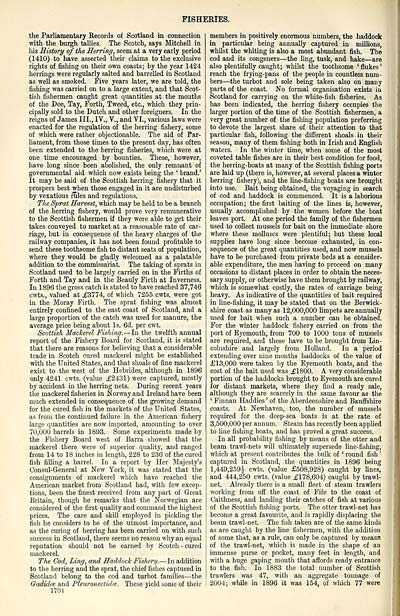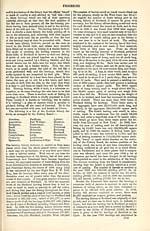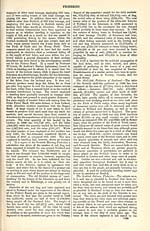Ordnance gazetteer of Scotland
(1712) Page 1704
Download files
Complete book:
Individual page:
Thumbnail gallery: Grid view | List view

FISHERIES.
the Parliamentary Records of Scotland in connection
with the burgh tallies. The Scotch, says Mitchell in
his History of the Herring, seem at a very early period
(1410) to have asserted their claims to the exclusive
rights of fishing on their own coasts; by the year 1424
herrings were regularly salted and barrelled in Scotland
as well as smoked. Five years later, we are told, the
fishing was carried on to a large extent, and that Scot-
tish fishermen caught great quantities at the mouths
of the Dee, Tay, Forth, Tweed, etc., which they prin-
cipally sold to the Dutch and other foreigners. In the
reigns of James III., IV., V., and VI., various laws were
enacted for the regulation of the herring fishery, some
of which were rather objectionable. The aid of Par-
liament, from those times to the present day, has often
been extended to the herring fisheries, which were at
one time encouraged by bounties. These, however,
have long since been abolished, the only remnant of
governmental aid which now exists being the ' brand.'
It may be said of the Scottish herring fishery that it
prospers best when those engaged in it are undisturbed
by vexatious rules and regulations.
The Sprat Harvest, which may be held to be a branch
of the herring fishery, would prove very remunerative
to the Scottish fishermen if they were able to get their
takes conveyed to market at a reasonable rate of car-
riage, but in consequence of the heavy charges of the
railway companies, it has not been found profitable to
send these toothsome fish to distant seats of population,
where they would be gladly welcomed as a palatable
addition to the commissariat. The taking of sprats in
Scotland used to be largely carried on in the Firths of
Forth and Tay and in the Beauly Firth at Inverness.
In 1896 the gross catch is stated to have reached 37,746
cwts., valued at £3774, of which 7255 cwts. were got
in the Moray Firth. The sprat fishing was almost
entirely confined to the east coast of Scotland, and a
large proportion of the catch was used for manure, the
average price being about Is. 6d. per cwt.
Scottish Mackerel Fishing. — In the twelfth annual
report of the Fishery Board for Scotland, it is stated
that there are reasons for believing that a considerable
trade in Scotch cured mackerel might be established
with the United States, and that shoals of fine mackerel
exist to the west of the Hebrides, although in 1896
only 4241 cwts. (value £2431) were captured, mostly
by accident in the herring nets. During recent years
the mackerel fisheries in Norway and Ireland have been
much extended in consequence of the growing demand
for the cured fish in the markets of the United States,
as from the continued failure in the American fishery
large quantities are now imported, amounting to over
70,000 barrels in 1893. Some experiments made by
the Fishery Board west of Barra showed that the
mackerel there were of superior quality, and ranged
from 14 to 18 inches in length, 228 to 236 of the cured
fish filling a barrel. In a report by Her Majesty's
Oonsul-General at New York, it was stated that the
consignments of mackerel which have reached the
American market from Scotland had, with few excep-
tions, been the finest received from any part of Great
Britain, though he remarks that the Norwegian are
considered of the first quality and command the highest
prices. The care and skill employed in pickling the
fish he considers to be of the utmost importance, and
as the curing of herring has been carried on with such
success in Scotland, there seems no reason why an equal
reputation should not be earned by Scotch - cured
mackerel.
The Cod, Ling, and Haddock Fishery. — In addition
to the herring and the sprat, the chief fishes captured in
Scotland belong to the cod and turbot families — the
Gadidte and Pleuronectidos. These yield some of their
1701
members in positively enormous numbers, the haddock
in particular being annually captured in millions,
whilst the whiting is also a most abundant fish. The
cod and its congeners — the ling, tusk, and hake — are
also plentifully caught; whilst the toothsome 'flukes'
reach the frying-pans of the people in countless num-
bers — the turbot and sole being taken also on many
parts of the coast. No formal organisation exists in
Scotland for carrying on the white-fish fisheries. As
has been indicated, the herring fishery occupies the
larger portion of the time of the Scottish fishermen, a
very great number of the fishing population preferring
to devote the largest share of their attention to that
particular fish, following the different shoals in their
season, many of them fishing both in Irish and English
waters. In the winter time, when some of the most
coveted table fishes are in their best condition for food,
the herring-boats at many of the Scottish fishing ports
are laid up (there is, however, at several places a winter
herring fishery), and. the line-fishing boats are brought
into use. Bait being obtained, the voyaging in search
of cod and haddock is commenced. It is a laborious
occupation; the first baiting of the lines is, however,
usually accomplished by the women before the boat
leaves port. At one period the family of the fishermen
used to collect mussels for bait on the immediate shore
where these molluscs were plentiful; but these local
supplies have long since become exhausted, in con-
sequence of the great quantities used, and now mussels
have to be purchased from private beds at a consider-
able expenditure, the men having to proceed on many
occasions to distant places in order to obtain the neces-
sary supply, or otherwise have them brought by railway,
which is somewhat costly, the rates of carriage being
heavy. As indicative of the quantities of bait required
in line-fishing, it may be stated that on the Berwick-
shire coast as many as 12,000,000 limpets are annually
used for bait when such a number can be obtained.
For the winter haddock fishery carried on from the
port of Eyemouth, from 700 to 1000 tons of mussels
are required, and these have to be brought from Lin-
colnshire and largely from Holland. In a period
extending over nine months haddocks of the value of
£13,000 were taken by the Eyemouth boats, and the
cost of the bait used was £1800. A very considerable
portion of the haddocks brought to Eyemouth are cured
for distant markets, where they find a ready sale,
although they are scarcely in the same favour as the
' Finnan Haddies ' of the Aberdeenshire and Banffshire
coasts. At Newhaven, too, the number of mussels
required for the deep-sea boats is at the rate of
3,500,000 per annum. Steam has recently been applied
to line fishing boats, and has proved a great success.
In all probability fishing by means of the otter and
beam trawl-nets will ultimately supersede line-fishing,
which at present contributes the bulk of ' round fish '
captured in Scotland, the quantities in 1896 being
1,449,259J cwts. (value £508,928) caught by lines,
and 444,250 cwts. (value £178,604) caught by trawl-
net. Already there is a small fleet of steam trawlers
working from off the coast of Fife to the coast of
Caithness, and landing their catches of fish at various
of the Scottish fishing ports. The otter trawl-net has
become a great favourite, and is rapidly displacing the
beam trawl-net. The fish taken are of the same kinds
as are caught by the line fishermen, with the addition
of some that, as a rule, can only be captured by means
of the trawl-net, which is made in the shape of an
immense purse or pocket, many feet in length, and
with a huge gaping mouth that affords ready entrance
to the fish. In 1883 the total number of Scottish
trawlers was 47, with an aggregate tonnage of
2004; while in 1896 it was 154, of which 77 were
the Parliamentary Records of Scotland in connection
with the burgh tallies. The Scotch, says Mitchell in
his History of the Herring, seem at a very early period
(1410) to have asserted their claims to the exclusive
rights of fishing on their own coasts; by the year 1424
herrings were regularly salted and barrelled in Scotland
as well as smoked. Five years later, we are told, the
fishing was carried on to a large extent, and that Scot-
tish fishermen caught great quantities at the mouths
of the Dee, Tay, Forth, Tweed, etc., which they prin-
cipally sold to the Dutch and other foreigners. In the
reigns of James III., IV., V., and VI., various laws were
enacted for the regulation of the herring fishery, some
of which were rather objectionable. The aid of Par-
liament, from those times to the present day, has often
been extended to the herring fisheries, which were at
one time encouraged by bounties. These, however,
have long since been abolished, the only remnant of
governmental aid which now exists being the ' brand.'
It may be said of the Scottish herring fishery that it
prospers best when those engaged in it are undisturbed
by vexatious rules and regulations.
The Sprat Harvest, which may be held to be a branch
of the herring fishery, would prove very remunerative
to the Scottish fishermen if they were able to get their
takes conveyed to market at a reasonable rate of car-
riage, but in consequence of the heavy charges of the
railway companies, it has not been found profitable to
send these toothsome fish to distant seats of population,
where they would be gladly welcomed as a palatable
addition to the commissariat. The taking of sprats in
Scotland used to be largely carried on in the Firths of
Forth and Tay and in the Beauly Firth at Inverness.
In 1896 the gross catch is stated to have reached 37,746
cwts., valued at £3774, of which 7255 cwts. were got
in the Moray Firth. The sprat fishing was almost
entirely confined to the east coast of Scotland, and a
large proportion of the catch was used for manure, the
average price being about Is. 6d. per cwt.
Scottish Mackerel Fishing. — In the twelfth annual
report of the Fishery Board for Scotland, it is stated
that there are reasons for believing that a considerable
trade in Scotch cured mackerel might be established
with the United States, and that shoals of fine mackerel
exist to the west of the Hebrides, although in 1896
only 4241 cwts. (value £2431) were captured, mostly
by accident in the herring nets. During recent years
the mackerel fisheries in Norway and Ireland have been
much extended in consequence of the growing demand
for the cured fish in the markets of the United States,
as from the continued failure in the American fishery
large quantities are now imported, amounting to over
70,000 barrels in 1893. Some experiments made by
the Fishery Board west of Barra showed that the
mackerel there were of superior quality, and ranged
from 14 to 18 inches in length, 228 to 236 of the cured
fish filling a barrel. In a report by Her Majesty's
Oonsul-General at New York, it was stated that the
consignments of mackerel which have reached the
American market from Scotland had, with few excep-
tions, been the finest received from any part of Great
Britain, though he remarks that the Norwegian are
considered of the first quality and command the highest
prices. The care and skill employed in pickling the
fish he considers to be of the utmost importance, and
as the curing of herring has been carried on with such
success in Scotland, there seems no reason why an equal
reputation should not be earned by Scotch - cured
mackerel.
The Cod, Ling, and Haddock Fishery. — In addition
to the herring and the sprat, the chief fishes captured in
Scotland belong to the cod and turbot families — the
Gadidte and Pleuronectidos. These yield some of their
1701
members in positively enormous numbers, the haddock
in particular being annually captured in millions,
whilst the whiting is also a most abundant fish. The
cod and its congeners — the ling, tusk, and hake — are
also plentifully caught; whilst the toothsome 'flukes'
reach the frying-pans of the people in countless num-
bers — the turbot and sole being taken also on many
parts of the coast. No formal organisation exists in
Scotland for carrying on the white-fish fisheries. As
has been indicated, the herring fishery occupies the
larger portion of the time of the Scottish fishermen, a
very great number of the fishing population preferring
to devote the largest share of their attention to that
particular fish, following the different shoals in their
season, many of them fishing both in Irish and English
waters. In the winter time, when some of the most
coveted table fishes are in their best condition for food,
the herring-boats at many of the Scottish fishing ports
are laid up (there is, however, at several places a winter
herring fishery), and. the line-fishing boats are brought
into use. Bait being obtained, the voyaging in search
of cod and haddock is commenced. It is a laborious
occupation; the first baiting of the lines is, however,
usually accomplished by the women before the boat
leaves port. At one period the family of the fishermen
used to collect mussels for bait on the immediate shore
where these molluscs were plentiful; but these local
supplies have long since become exhausted, in con-
sequence of the great quantities used, and now mussels
have to be purchased from private beds at a consider-
able expenditure, the men having to proceed on many
occasions to distant places in order to obtain the neces-
sary supply, or otherwise have them brought by railway,
which is somewhat costly, the rates of carriage being
heavy. As indicative of the quantities of bait required
in line-fishing, it may be stated that on the Berwick-
shire coast as many as 12,000,000 limpets are annually
used for bait when such a number can be obtained.
For the winter haddock fishery carried on from the
port of Eyemouth, from 700 to 1000 tons of mussels
are required, and these have to be brought from Lin-
colnshire and largely from Holland. In a period
extending over nine months haddocks of the value of
£13,000 were taken by the Eyemouth boats, and the
cost of the bait used was £1800. A very considerable
portion of the haddocks brought to Eyemouth are cured
for distant markets, where they find a ready sale,
although they are scarcely in the same favour as the
' Finnan Haddies ' of the Aberdeenshire and Banffshire
coasts. At Newhaven, too, the number of mussels
required for the deep-sea boats is at the rate of
3,500,000 per annum. Steam has recently been applied
to line fishing boats, and has proved a great success.
In all probability fishing by means of the otter and
beam trawl-nets will ultimately supersede line-fishing,
which at present contributes the bulk of ' round fish '
captured in Scotland, the quantities in 1896 being
1,449,259J cwts. (value £508,928) caught by lines,
and 444,250 cwts. (value £178,604) caught by trawl-
net. Already there is a small fleet of steam trawlers
working from off the coast of Fife to the coast of
Caithness, and landing their catches of fish at various
of the Scottish fishing ports. The otter trawl-net has
become a great favourite, and is rapidly displacing the
beam trawl-net. The fish taken are of the same kinds
as are caught by the line fishermen, with the addition
of some that, as a rule, can only be captured by means
of the trawl-net, which is made in the shape of an
immense purse or pocket, many feet in length, and
with a huge gaping mouth that affords ready entrance
to the fish. In 1883 the total number of Scottish
trawlers was 47, with an aggregate tonnage of
2004; while in 1896 it was 154, of which 77 were
Set display mode to: Large image | Transcription
Images and transcriptions on this page, including medium image downloads, may be used under the Creative Commons Attribution 4.0 International Licence unless otherwise stated. ![]()
| Gazetteers of Scotland, 1803-1901 > Ordnance gazetteer of Scotland > (1712) Page 1704 |
|---|
| Permanent URL | https://digital.nls.uk/97413790 |
|---|

